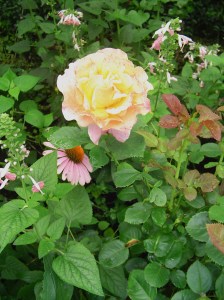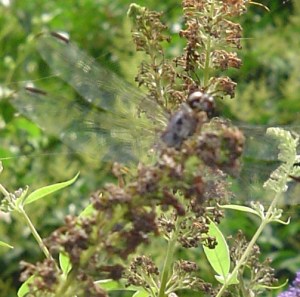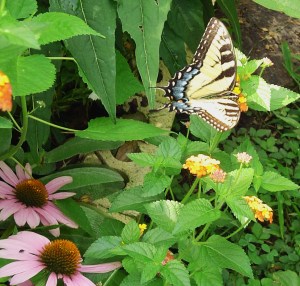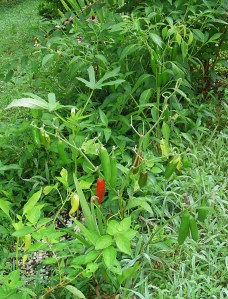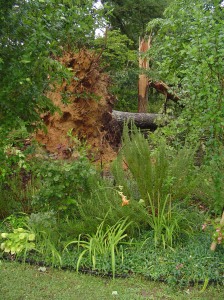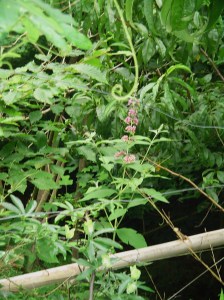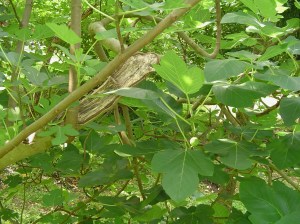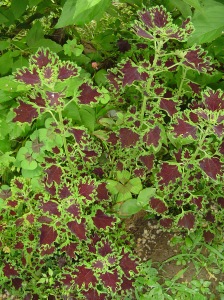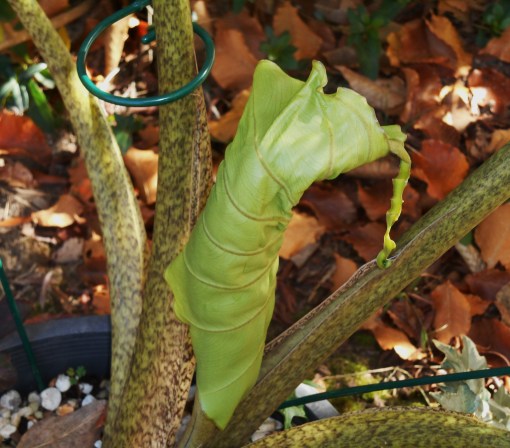
A new leaf of Alocasia ‘Stingray’ is opening, even as we bring our tender plants in for autumn.
~
It’s hard to know these days whether we live in Zone 7b or 8a. Technically, by the map, James City County is rated in hardiness Zone 7b, which means we might have winter temperatures as low as 5-10F. I can’t remember the last time it grew that cold here. But I’ll accept it’s possible.
Beyond the lowest winter temperature, climate zone also informs us when to expect the first freezing temperatures of autumn and the last freeze in spring. The first frost date for Zone 7b falls on October 15; the first frost in Zone 8a falls a month later on November 15. That said, we’ve not yet had a night colder than 40F.
But, the cold is definitely coming. Which is why we’ve devoted the last several days to moving as many tender potted plants as possible back indoors for the winter.
~
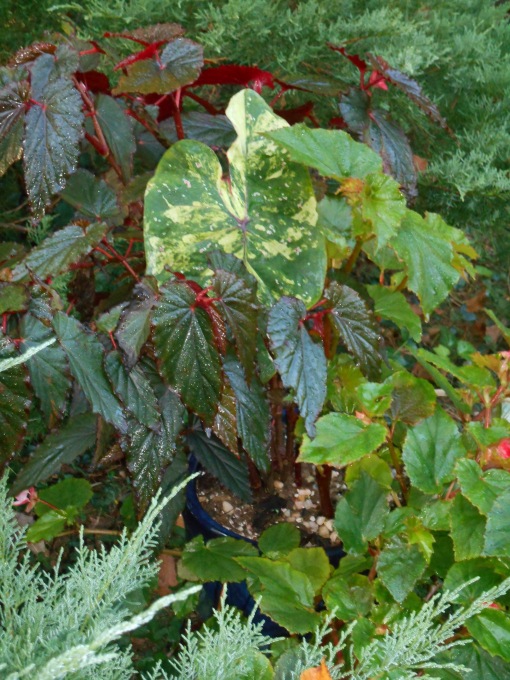
This Caladium, ‘Sweet Carolina,’ came indoors this week in its pot, with its companion Begonias.
~
I like to prioritize and organize, especially when the forecast fluctuates and one can’t be certain when that first freeze will come. (It’s a game of chance, calculating how long to wait before beginning the annual migration. While it must be finished before frost, the plants benefit from every sunny warmish autumn day they can remain out in the garden.)
I began with the Caladiums, perhaps the most tender of our tropical plants. I’ve dried most of the tubers, packed them carefully, and brought them inside for warm storage during the winter. But, hedging my bets, lots are still left growing in pots indoors. I’ve had good success overwintering Caladium tubers in pots with other plants. While they like heat and prefer a spot in the living room, they will survive in pots kept in the garage. While they never freeze there, the temperatures may dip into the 40s some nights. Even potted Caladiums will soon go dormant, but may delight us with new growth in January or February.
~
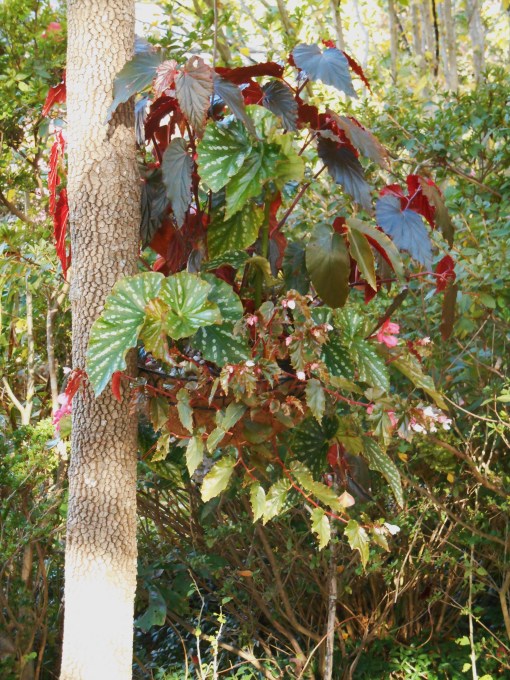
This mixed basket of Begonias, all started fresh from cuttings in May, has moved into the living room for the winter. I set baskets like this into deep clear plastic containers so they can be watered without making a huge mess.
~
The fall migration always calls for some repotting, and more this year than some. The Norfolk Island Pine dislikes night time temperatures below 50F. Giving ours a new pot, and a new, lower stand indoors, was high on the list. While ours touched the ceiling on its old stand last year, it has grown several inches over summer on the patio. It sits on a much lower table now in the corner of our hall, draped in white lights, and awaiting its holiday dressing with blown glass balls.
Our Begonias and ferns grew more this summer than I’d realized. Some are positively huge! I look at photos taken in early summer and marvel at how much growth they’ve given us this year. Finding space for each pot and basket remains a challenge. I’ve coped this year by cutting some of the cane Begonias back hard before moving them. I’ve gathered the cut stems into vases, hoping most will root. When there isn’t space for all of the pots, at least one can keep a favorite plant going over winter as a cutting.
~
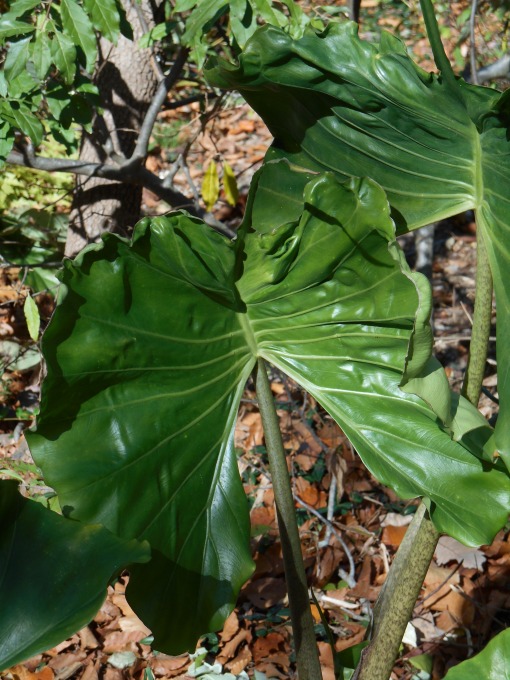
Alocasia ‘Stingray’ has an interesting leaf. Can you see the narrow ‘tail’ formed by the tip of the leaf? Our largest leaf has grown to nearly 2′ wide.
~
We use empty buckets, arranged on large plastic bags, to hold those hanging baskets we plan to keep over winter. The baskets sit all in a long row along one wall of the garage, under the bank of windows. They are messy to water, especially those more than a year old. The potting soil is dense with roots, and poured water tends to run off. We use blown glass globes to keep them hydrated. I fill the globes with water a few times each week, through the winter, to keep the soil moist enough for the plants to survive.
Plastic picnic tablecloths cover the garage floor where I mass our pots. Although each pot has its own saucer or plate, the plastic catches spills, overfills, and fallen leaves. This isn’t a neat project, but one well worth the trouble to keep plants from season to season.
~

Bougainvillea
~
The Bougainvillea vines have been covered in blooms, loving the autumn sunshine on the patio. I wish we could leave them in place year round, but they are too tender to survive a freeze. Old plants now, their long stems are 8′-12′ long, branched and thorny. Their pots don’t require much space, but their stems make them hard to place in the garage. Some years they keep blooming right through January!
It is quite a production to bring them in, and so we did it today while we had sunshine and a little warmth.
~

~
Today we also finally repotted the largest and oldest of our cane Begonias. It had been in its current plastic pot for nearly a decade. The plant, itself, was nearly 6′ tall and its long canes reached out in every direction. I had to prune it hard, first; clean out fallen leaves and old wood; and then free the root ball from its sadly disintegrating pot. Its new, larger 20″ square pot accepted the roots with room to spare (whew!) and looks so much better! We found space for the pot in the garage, where this venerable old Begonia will get lots of winter sun. But I’m even more excited that there will soon be lots of rooted cuttings to share.
~
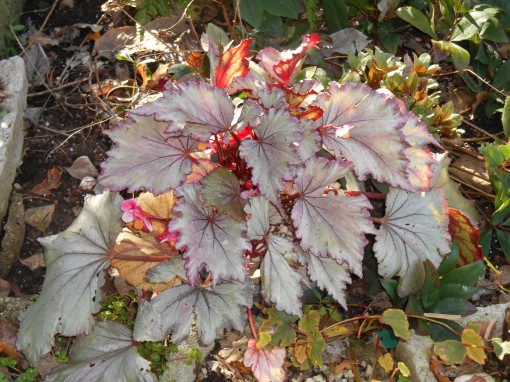
This Begonia has spent the last four winters indoors, and comes back each summer better than ever before.
~
And finally, it was time to work with our huge new Alocasias. Although these tubers are sometimes sold dry and dormant, I decided to try to keep the plants in leaf through winter, in the garage. Some may be marginally hardy here, but I don’t really want to take that chance. We lifted A. Sarian from its pot on Monday, and replanted it into a much smaller pot for winter. Its long petioles reach high, to let each leaf capture as much sun as possible.
A. Plumbea, hardy only to Zone 9, was lifted from the ground into a new pot last week, but left out on the patio to adjust. Our huge and beautiful A. ‘Stingray,’ which have greeted us beside the drive all summer, came in today, too. One pot stands in the garage, the other is nestled into the sunniest part of our front patio, sheltered by a brick wall. A. ‘Stingray,’ hardy to Zone 8, might make it through winter in its huge pot, sheltered in this sunny spot on the patio.
~
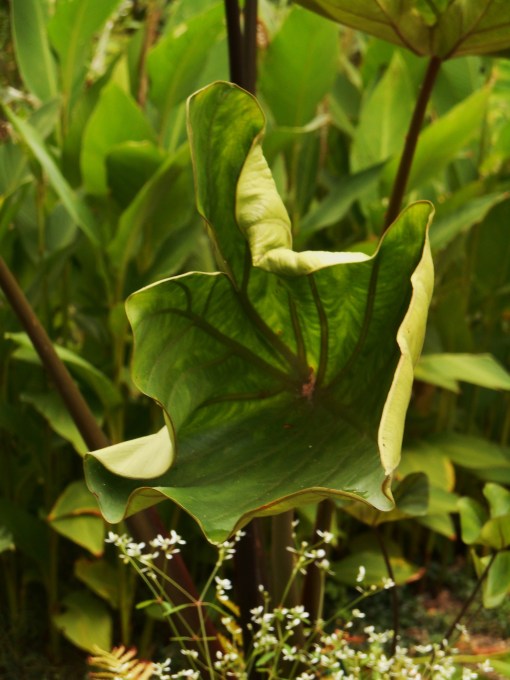
Colocasia ‘Tea cups’ is hardy to Zone 7. I’ve left it outside in its pot, hoping it will make it through the winter. I brought a little division indoors in a pot.
~
The front patio also shelters several tender trees, like pomegranate, olive, and grapefruit. I usually wait until bitter cold sets in, 20s at least, to move these indoors. They appreciate the sun, and can survive a light freeze.
Over the years I’ve learned to think strategically about holding plants through the winter. A huge pot of Colocasia ‘Mojito,’ kept in the basement last year, didn’t come in today. It was late afternoon when I came to it, and I was already running on fumes.
~

Colocasia ‘Mojito’
~
Instead, I divided the Colocasia and repotted just a few tubers of it into a much smaller pot, setting the remaining tubers out into the soil. I’ve had some luck with Colocasia cultivars rated to Zone 8 overwintering in the ground in this garden, and I decided to give it a try. We brought the smaller pot in to keep overwinter in the basement as ‘insurance.’ I ended up doing the same thing with our Colocasia ‘tea cups.’ Another massive plant, I left the main tuber in its large pot in the garden, but potted up one of its little offspring tubers to bring indoors. It is supposed to be hardy in Zone 7, and so I’m hopeful it will survive our winters in its pot.
~
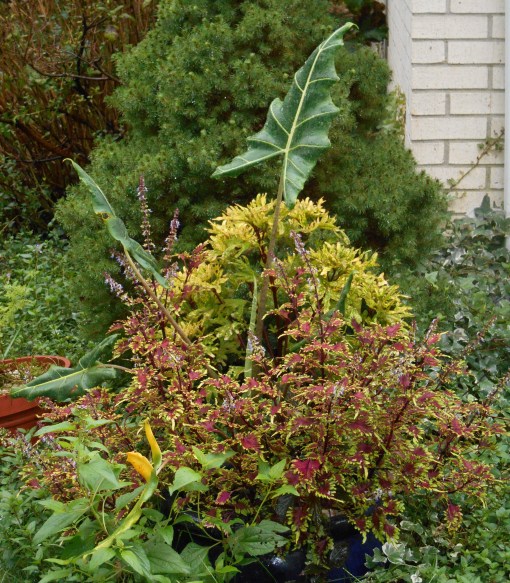
Alocasia ‘Sarian,’ hardy only to zone 9, came to us in a 4″ pot in late May. It didn’t reach its 6′ potential this year, but maybe next year? The Coleus surrounding it, grown from cuttings, will be replaced next year.
~
Smaller plants get dug up and tucked into largish pots of other plants. I’ve brought in a few tiny Begonias today in the palm of my hand, transplanting them in with something else. I’ve done the same with tender ferns and vines, planting them into a pot of Caladium ‘Moonlight’ tubers.
All of our beautiful geraniums still sit out in the cold. I’ve not had energy or space for a single one so far. Our first night down into the 30s is forecast for Friday or Saturday night. Although tender, geraniums can be found in abundance each spring. And they don’t much like overwintering in our garage. If I save any, it will be some of the scented Pelargoniums.
~
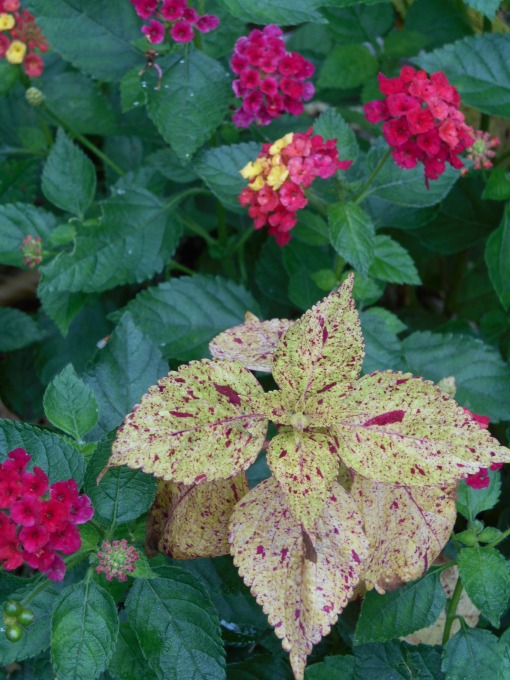
Some Lantana prove hardy for us, others don’t make it through the winter. This has been an especially nice Coleus and I’ll likely take cuttings before frost. The colors of both plants grow more intense in late autumn as night time temperatures cool.
~
It is hard to watch favorite plants wither after the first frost. I gave some potted Begonias and some cuttings to a neighbor today. I’ve run out of space to keep them. There are other pots of coleus and Euphorbia, geraniums and impatiens which won’t make it indoors before the coming freeze. It makes me sad to see them freeze, but I’ve learned that these plants, kept over winter, won’t grow as well or as vibrantly next season. Sometimes it is better to begin again with new plants and new soil in spring.
Each turn of the seasons offers an opportunity begin again; a fresh start. We get to apply what we’ve learned, but to do it differently. Empty pots now, perhaps; but in a few months they will stand ready to replant. We’ll have the fun of choosing new plants and creating new combinations with them.
Surely, we’ll learn something new, too.
~
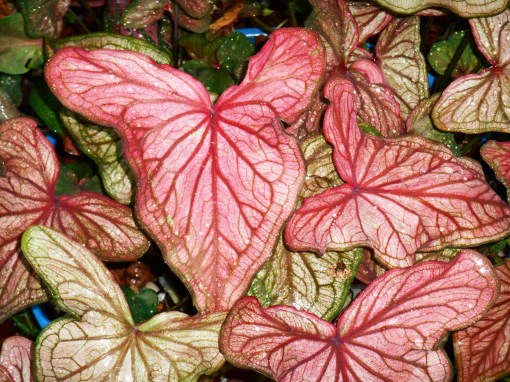
~
Woodland Gnome 2016
~
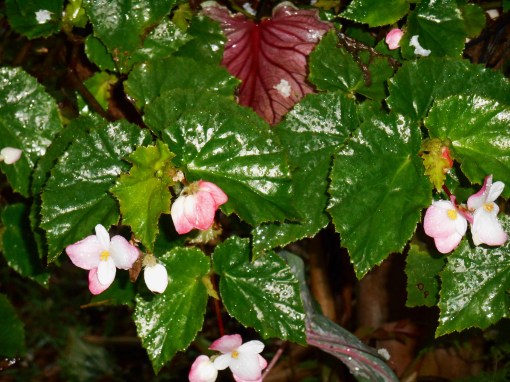
Begonia ‘Richmondensis’ will bloom indoors through the winter.
